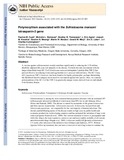| dc.contributor.author | Cupit, PM | |
| dc.contributor.author | Steinauer, ML | |
| dc.contributor.author | Tonnessen, BW | |
| dc.contributor.author | Eric Agola, L | |
| dc.contributor.author | Kinuthia, JM | |
| dc.contributor.author | Mwangi, IN | |
| dc.contributor.author | Mutuku, MW | |
| dc.contributor.author | Mkoji, GM | |
| dc.contributor.author | Loker, ES | |
| dc.contributor.author | Cunningham, C | |
| dc.date.accessioned | 2013-10-11T09:20:49Z | |
| dc.date.available | 2013-10-11T09:20:49Z | |
| dc.date.issued | 2011 | |
| dc.identifier.citation | Int J Parasitol. 2011 Oct;41(12):1249-52 | en |
| dc.identifier.uri | http://www.ncbi.nlm.nih.gov/pubmed/21889508 | |
| dc.identifier.uri | http://erepository.uonbi.ac.ke:8080/xmlui/handle/123456789/57594 | |
| dc.description.abstract | A vaccine against schistosomiasis would contribute significantly to reducing the 3-70 million disability-adjusted life years lost annually to the disease. Towards this end, inoculation with the large extracellular loop (EC-2) of Schistosoma mansoni tetraspanin-2 protein (Sm-TSP-2) has proved effective in reducing worm and egg burdens in S. mansoni-infected mice. The EC-2 loop of Schistosoma japonicum TSP-2, however, has been found to be highly polymorphic, perhaps diminishing the likelihood that this antigen can be used for vaccination against this species. Here, we examine polymorphism of the EC-2 of Sm-TSP-2 in genetically unique worms derived from six individuals from Kisumu, Kenya. | en |
| dc.language.iso | en | en |
| dc.publisher | Elsevier | en |
| dc.title | Polymorphism associated with the Schistosoma mansoni tetraspanin-2 gene. | en |
| dc.type | Article | en |
| local.publisher | Center for Evolutionary and Theoretical Immunology, Department of Biology, University of New Mexico, Albuquerque, NM 87131, USA. | en |


